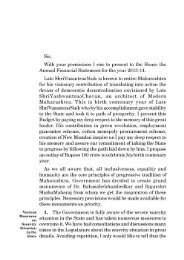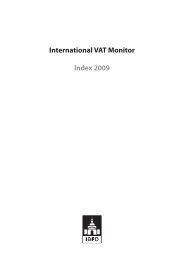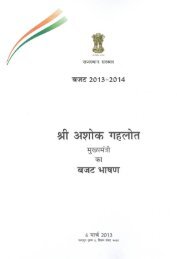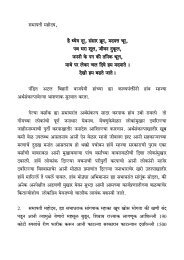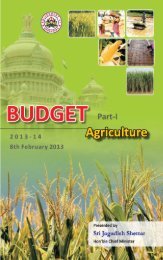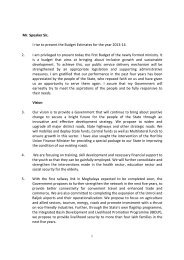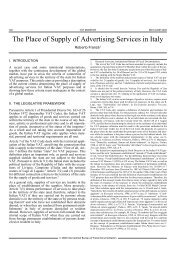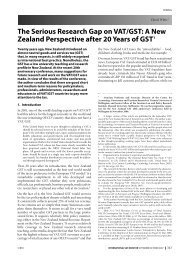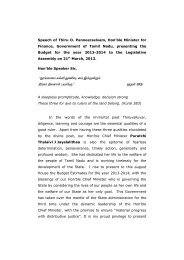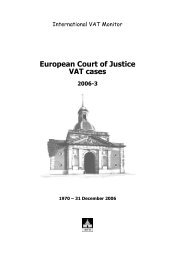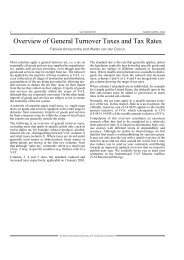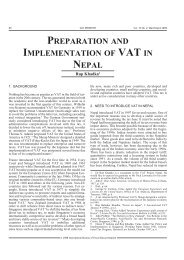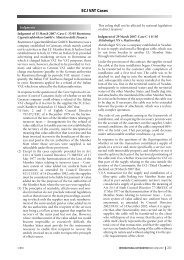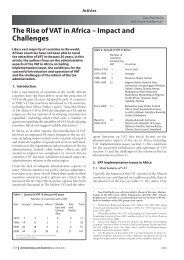VAT News - empcom.gov.in
VAT News - empcom.gov.in
VAT News - empcom.gov.in
You also want an ePaper? Increase the reach of your titles
YUMPU automatically turns print PDFs into web optimized ePapers that Google loves.
aga<strong>in</strong>st <strong>VAT</strong> fraud <strong>in</strong> the European Union, which was<br />
presented on 1 December 2008.<br />
The sem<strong>in</strong>ar brought together representatives from<br />
bus<strong>in</strong>esses, the national tax adm<strong>in</strong>istrations and European<br />
<strong>in</strong>stitutions. It focused on both short-term and<br />
longer-term measures to combat <strong>VAT</strong> fraud. All presentations<br />
are available on TAXUD’s website.<br />
European Commission’s website.<br />
Reduced <strong>VAT</strong> rates – Ecof<strong>in</strong><br />
At the meet<strong>in</strong>g of the EU Council for Economic and<br />
F<strong>in</strong>ancial Affairs (Ecof<strong>in</strong> Council) on 10 February 2009,<br />
the Council discussed the issue of reduced rates of <strong>VAT</strong><br />
<strong>in</strong> the context of the economic recovery plan approved<br />
by the European Council <strong>in</strong> December 2008.<br />
The presidency <strong>in</strong>dicated that it will reflect on how to<br />
take the dossier forward <strong>in</strong> response to the European<br />
Council’s request to settle the issue by March 2009. A further<br />
discussion is expected at the Council’s meet<strong>in</strong>g on<br />
10 March 2009, <strong>in</strong> the run-up to the next European<br />
Council, on 19 and 20 March 2009.<br />
Allow<strong>in</strong>g Member States to apply reduced <strong>VAT</strong> rates <strong>in</strong><br />
certa<strong>in</strong> sectors is one of the actions that form part of the<br />
economic recovery plan.<br />
The current EU rules on <strong>VAT</strong> rates are set by Directive<br />
200 /112. They are the outcome of a variety of <strong>in</strong>itiatives<br />
over the years, <strong>in</strong>clud<strong>in</strong>g the 1992 decision on the harmonization<br />
of <strong>VAT</strong> rates <strong>in</strong> the context of the EU s<strong>in</strong>gle<br />
market, the 2000 decision to temporarily allow reduced<br />
<strong>VAT</strong> rates on labour-<strong>in</strong>tensive services with a view to<br />
stimulat<strong>in</strong>g employment, and the 2004 derogations<br />
allowed to newly acceded Member States. In addition,<br />
the Commission promised to present a proposal <strong>in</strong> April<br />
2009 on the application of reduced rates to specific environmental<br />
goods and services, focus<strong>in</strong>g pr<strong>in</strong>cipally on<br />
energy efficiency <strong>in</strong> build<strong>in</strong>gs.<br />
In 2008, the Commission proposed a Directive aimed at<br />
allow<strong>in</strong>g all Member States to apply reduced rates – on a<br />
permanent basis – to labour-<strong>in</strong>tensive services, <strong>in</strong>clud<strong>in</strong>g<br />
restaurant services. 1<br />
Reduced <strong>VAT</strong> on environment-friendly products –<br />
Study<br />
On 2 January 2009, the European Commission published<br />
a study on the current and potential use of<br />
reduced <strong>VAT</strong> for environment-friendly products, and its<br />
application to energy consumption by households. The<br />
analysis is carried out <strong>in</strong> the context of EU policy<br />
approach to climate change and energy security, <strong>in</strong>clud<strong>in</strong>g<br />
<strong>in</strong>teraction with other policy <strong>in</strong>struments at EU and<br />
national levels. The study focuses on what role – if any –<br />
<strong>VAT</strong> rate policy should play <strong>in</strong> underp<strong>in</strong>n<strong>in</strong>g these<br />
objectives.<br />
European Commission’s website.<br />
© IBFD INTERNATIONAL <strong>VAT</strong> MONITOR MARCH/APRIL 2009<br />
Fiji<br />
<strong>VAT</strong> <strong>News</strong><br />
Zero rat<strong>in</strong>g<br />
The Budget for 2009 was presented on 21 November<br />
2008. Under the budget, the zero rat<strong>in</strong>g of goods for <strong>VAT</strong><br />
purposes only applies from 1 January 2009 on the condition<br />
that evidence is provided to the Commissioner that<br />
the proceeds of the exported goods and services are<br />
transferred to Fiji.<br />
F<strong>in</strong>land<br />
Tax accounts<br />
The <strong>gov</strong>ernment has proposed a new system for report<strong>in</strong>g,<br />
pay<strong>in</strong>g and reclaim<strong>in</strong>g taxes through “tax accounts”.<br />
If approved as proposed, the system will come <strong>in</strong>to force<br />
at the beg<strong>in</strong>n<strong>in</strong>g of the year 2010 and, at the <strong>in</strong>itial stage,<br />
applies to “self-assessed” taxes, i.e. taxes that are reported<br />
and paid on the entrepreneurs’ <strong>in</strong>itiative, <strong>in</strong>clud<strong>in</strong>g <strong>VAT</strong>,<br />
withhold<strong>in</strong>g tax, social security tax, tax at source, <strong>in</strong>surance<br />
premium tax and lottery tax. The proposal therefore<br />
also conta<strong>in</strong>s many amendments to, <strong>in</strong>ter alia, the<br />
<strong>VAT</strong> Act. At the second stage, which is envisaged to commence<br />
<strong>in</strong> the year 2012, the tax account system will be<br />
extended to the other taxes.<br />
The ma<strong>in</strong> purpose of the new tax account system is to<br />
make the tax collection system more taxpayer friendly<br />
and cost efficient for both the tax authorities and entrepreneurs.<br />
The new system will provide every taxpayer<br />
with his own tax account, which they will use for fil<strong>in</strong>g<br />
tax returns and declarations and mak<strong>in</strong>g payments. The<br />
account may also conta<strong>in</strong> other <strong>in</strong>formation regard<strong>in</strong>g<br />
the taxpayer’s tax position.<br />
The deadl<strong>in</strong>es for report<strong>in</strong>g and pay<strong>in</strong>g taxes will be unified<br />
under the new system. The unified due date is proposed<br />
to be the 12th day of the month follow<strong>in</strong>g the<br />
month to which the report relates. The ultimate goal is to<br />
enable taxpayers to file only a s<strong>in</strong>gle monthly tax report<br />
conta<strong>in</strong><strong>in</strong>g <strong>in</strong>formation on all tax liabilities and, consequently,<br />
make only a s<strong>in</strong>gle monthly payment cover<strong>in</strong>g<br />
all taxes due for that month. The tax authorities will allocate<br />
the total amount received to the taxes due, on the<br />
basis of a method laid down by the law.<br />
The tax account system will prevent unnecessary money<br />
transfers between the tax authorities and taxpayers. For<br />
example, entrepreneurs will no longer have to apply for a<br />
refund of <strong>VAT</strong> because their <strong>VAT</strong> claim will automatically<br />
be offset aga<strong>in</strong>st their other tax liabilities or, alternatively,<br />
be refunded.<br />
Taxpayers will be liable for payment of late-payment<br />
<strong>in</strong>terest and, on the other hand, receive <strong>in</strong>terest for any<br />
credit balance <strong>in</strong> their tax account. Late payment of <strong>VAT</strong><br />
will no longer give rise to imposition of a penalty. How-<br />
1 . Proposal for a Council Directive amend<strong>in</strong>g Directive 200 /112/EC as<br />
regards reduced rates of value added tax, COM(2008) 428.<br />
14



